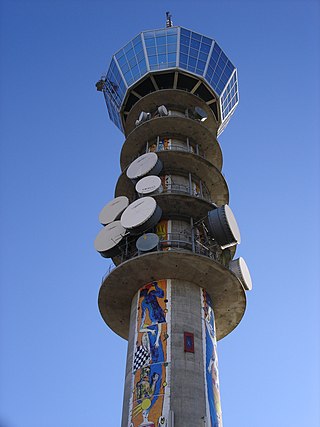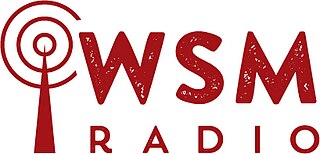
Shortwave radio is radio transmission using radio frequencies in the shortwave bands (SW). There is no official definition of the band range, but it always includes all of the high frequency band (HF), which extends from 3 to 30 MHz. It lies between the medium frequency band (MF) and the bottom of the VHF band.
FM broadcasting in the United States began in the 1930s at engineer and inventor Edwin Howard Armstrong's experimental station, W2XMN. The use of FM radio has been associated with higher sound quality in music radio.

Very high frequency (VHF) is the ITU designation for the range of radio frequency electromagnetic waves from 30 to 300 megahertz (MHz), with corresponding wavelengths of ten meters to one meter. Frequencies immediately below VHF are denoted high frequency (HF), and the next higher frequencies are known as ultra high frequency (UHF).

Medium frequency (MF) is the ITU designation for radio frequencies (RF) in the range of 300 kilohertz (kHz) to 3 megahertz (MHz). Part of this band is the medium wave (MW) AM broadcast band. The MF band is also known as the hectometer band as the wavelengths range from ten to one hectometers. Frequencies immediately below MF are denoted as low frequency (LF), while the first band of higher frequencies is known as high frequency (HF). MF is mostly used for AM radio broadcasting, navigational radio beacons, maritime ship-to-shore communication, and transoceanic air traffic control.

In radio, longwave, long wave or long-wave, and commonly abbreviated LW, refers to parts of the radio spectrum with wavelengths longer than what was originally called the medium-wave broadcasting band. The term is historic, dating from the early 20th century, when the radio spectrum was considered to consist of longwave (LW), medium-wave (MW), and short-wave (SW) radio bands. Most modern radio systems and devices use wavelengths which would then have been considered 'ultra-short'.

Radio broadcasting is the broadcasting of audio (sound), sometimes with related metadata, by radio waves to radio receivers belonging to a public audience. In terrestrial radio broadcasting the radio waves are broadcast by a land-based radio station, while in satellite radio the radio waves are broadcast by a satellite in Earth orbit. To receive the content the listener must have a broadcast radio receiver (radio). Stations are often affiliated with a radio network that provides content in a common radio format, either in broadcast syndication or simulcast, or both. The encoding of a radio broadcast depends on whether it uses an analog or digital signal. Analog radio broadcasts use one of two types of radio wave modulation: amplitude modulation for AM radio, or frequency modulation for FM radio. Newer, digital radio stations transmit in several different digital audio standards, such as DAB, HD radio, or DRM.

High frequency (HF) is the ITU designation for the band of radio waves with frequency between 3 and 30 megahertz (MHz). It is also known as the decameter band or decameter wave as its wavelengths range from one to ten decameters. Frequencies immediately below HF are denoted medium frequency (MF), while the next band of higher frequencies is known as the very high frequency (VHF) band. The HF band is a major part of the shortwave band of frequencies, so communication at these frequencies is often called shortwave radio. Because radio waves in this band can be reflected back to Earth by the ionosphere layer in the atmosphere – a method known as "skip" or "skywave" propagation – these frequencies can be used for long-distance communication across intercontinental distances and for mountainous terrains which prevent line-of-sight communications. The band is used by international shortwave broadcasting stations (3.95–25.82 MHz), aviation communication, government time stations, weather stations, amateur radio and citizens band services, among other uses.
Radio propagation is the behavior of radio waves as they travel, or are propagated, from one point to another in vacuum, or into various parts of the atmosphere. As a form of electromagnetic radiation, like light waves, radio waves are affected by the phenomena of reflection, refraction, diffraction, absorption, polarization, and scattering. Understanding the effects of varying conditions on radio propagation has many practical applications, from choosing frequencies for amateur radio communications, international shortwave broadcasters, to designing reliable mobile telephone systems, to radio navigation, to operation of radar systems.

The FM broadcast band is a range of radio frequencies used for FM broadcasting by radio stations. The range of frequencies used differs between different parts of the world. In Europe and Africa and in Australia and New Zealand, it spans from 87.5 to 108 megahertz (MHz) - also known as VHF Band II - while in the Americas it ranges from 88 to 108 MHz. The FM broadcast band in Japan uses 76 to 95 MHz, and in Brazil, 76 to 108 MHz. The International Radio and Television Organisation (OIRT) band in Eastern Europe is from 65.9 to 74.0 MHz, although these countries now primarily use the 87.5 to 108 MHz band, as in the case of Russia. Some other countries have already discontinued the OIRT band and have changed to the 87.5 to 108 MHz band.

In radio communication, skywave or skip refers to the propagation of radio waves reflected or refracted back toward Earth from the ionosphere, an electrically charged layer of the upper atmosphere. Since it is not limited by the curvature of the Earth, skywave propagation can be used to communicate beyond the horizon, at intercontinental distances. It is mostly used in the shortwave frequency bands.

WSM is a commercial AM radio station, located in Nashville, Tennessee. It broadcasts a country music format and is known as the home of the Grand Ole Opry, the world's longest running radio program. The station is owned Ryman Hospitality Properties, Inc. After nearly 40 years broadcasting from a studio within the Gaylord Opryland Resort & Convention Center, WSM moved to a showcase studio inside the former home of Roy Acuff, just outside the Grand Ole Opry House, in July 2024.

FM broadcasting is a method of radio broadcasting that uses frequency modulation (FM) of the radio broadcast carrier wave. Invented in 1933 by American engineer Edwin Armstrong, wide-band FM is used worldwide to transmit high-fidelity sound over broadcast radio. FM broadcasting offers higher fidelity—more accurate reproduction of the original program sound—than other broadcasting techniques, such as AM broadcasting. It is also less susceptible to common forms of interference, having less static and popping sounds than are often heard on AM. Therefore, FM is used for most broadcasts of music and general audio. FM radio stations use the very high frequency range of radio frequencies.

WNYE is a non-commercial educational FM radio station licensed to New York, New York. The station is operated, along with WNYE-TV, by NYC Media, a division of the Mayor's Office of Media and Entertainment. Studios are located at the City University of New York's Graduate Center at 365 Fifth Avenue, and the transmitter is at the former Condé Nast Building.

WUKY is a listener-supported, public radio station in Lexington, Kentucky. Owned by the University of Kentucky (UK), it has an Adult Album Alternative radio format, airing more than 100 hours of music per week. Some news and informational programming is supplied by National Public Radio (NPR), Public Radio International (PRI), American Public Media (APM) and the BBC. The station broadcasts from state of the art radio studios in northwestern Lexington at the intersection of Greendale Road and Spurr Road.
Apex radio stations was the name commonly given to a short-lived group of United States broadcasting stations, which were used to evaluate transmitting on frequencies that were much higher than the ones used by standard amplitude modulation (AM) and shortwave stations. Their name came from the tall height of their transmitter antennas, which were needed because coverage was primarily limited to local line-of-sight distances. These stations were assigned to what at the time were described as "ultra-high shortwave" frequencies, between roughly 25 and 44 MHz. They employed amplitude modulation (AM) transmissions, although in most cases using a wider bandwidth than standard broadcast band AM stations, in order to provide high fidelity sound with less static and distortion.

WHCN is a commercial radio station licensed to Hartford, Connecticut. It broadcasts a classic hits radio format for the Hartford, Waterbury and New Haven areas, and is owned by iHeartMedia, Inc. It is branded "The River 105.9", a reference to the Connecticut River. Its studios and offices are located on Columbus Boulevard in Hartford.
WSM-FM was a commercial radio station that was operated by the National Life and Accident Insurance Company in Nashville, Tennessee, United States, beginning on March 1, 1941. Under its original call sign of W47NV, it was described at the time as the first fully licensed commercial FM station in the nation. However, after ten years of financial losses, the station ceased operations on March 15, 1951.
W8XH was a Buffalo, New York radio station, authorized by the Federal Communications Commission (FCC) as an "experimental audio station", which was owned by the Buffalo Evening News, and which operated from 1934 to 1939. It was the first apex band station, i.e. the first to transmit programming intended for the general public over what was then known as "ultra-high short-wave" frequencies. W8XH primarily simulcast programming originating from a co-owned AM radio station, WBEN, but it also aired some original programs. It ceased broadcasting in July 1939, after the newspaper began to focus on operation of an experimental facsimile broadcasting station, W8XA, which in turn shut down shortly prior to World War II and was succeeded after the war by the establishment of an FM station.
W8XWJ was a Detroit, Michigan "experimental audio broadcasting station", owned by the Detroit News, which operated from 1936 to 1940. It was classified as an Apex broadcasting station, i.e. it provided programming intended for the general public over what was then known as "ultra-high short-wave" frequencies. W8XWJ primarily broadcast unique programming, although it sometimes simulcast programs originating from co-owned AM station WWJ. In April 1940, W8XWJ was shut down, in order to be converted to a commercial FM station.
WGTR was a pioneer commercial FM radio station, which was the first of two mountain-top stations established by the Yankee Network. It began regular programming, as experimental station W1XOJ, in 1939. In 1941 it was licensed for commercial operation from studios in Boston, initially with the call sign W43B, which was changed to WGTR in 1943. In 1947, its designated community of license was changed to Worcester, Massachusetts.













